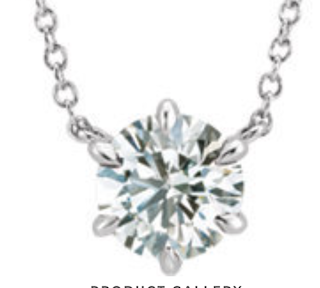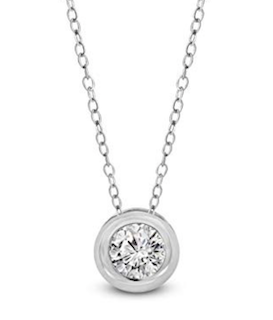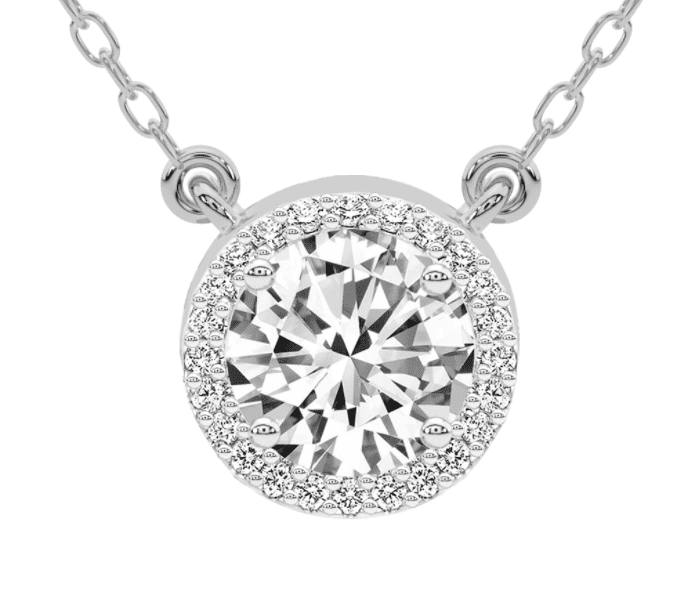Personally, I looooove love love a solitaire diamond necklace! I find them classy, timeless, and elegant. It is easily on my list of jewelry staples that are a necessity in life! I’ve got the rundown for you on what a solitaire diamond necklace actually is (plus the basic design options we have), what would be considered a good size for our diamond pendant, and how much a 1 carat diamond necklace is actually worth. Whether this is a gift for someone else or just a little something to spoil yourself, I promise it is solid purchase that will be loved on for years and years to come!
What is a Solitaire Diamond Necklace
In essence, this is simply a diamond pendant necklace with one lone diamond as the alluring focal point (couldn’t have guessed I know). The beauty of being solo though is in the fact that the single diamond is allowed to shine as the exquisite gemstone is.
Most often we see a round brilliant cut diamond used because of its inherent sparkle but honestly any shaped diamond would be perfect. If it speaks to you, feel free to get crazy with the silhouette! Maybe something like a princess, cushion, or emerald shaped diamond would be more of your personal flow (which still counts as a solitaire diamond).
Setting Style
There isn’t a whole lot of detailed design that goes into such an uncomplicated necklace style. This is really great for those of us who find endless options to be slightly overwhelming. So, our basic choices come down to the setting style and the metal material (which are two totally manageable decisions).
Prong Solitaire
A setting is what holds our diamond in place. In this specific circumstance, it is pretty much the only design flare we have (besides the shape of the diamond). In general, we have two standard setting styles that are commonly used: the prong and the bezel setting. Both of these can be used with any shape diamond and both are actually considered the most secure settings for gemstones over-all (so that’s extra awesome).
The prong setting looks like a little metal claw, with 4 or 6 rounded tips that come up and over the diamond, holding it firmly in place. The biggest benefit of the prong is that it allows light to penetrate the entire diamond, hit the proper angles, and then reflect back at you in a dazzling display of fire and sparkle.

The downside to the prong setting is that the prong tips can snag on clothing (and other things) if it gets too close. This could potentially loosen the prongs over time so it’s best to have said prongs checked occasionally as an extra precautions. Putting your necklace on last and taking it off first or wearing clothes that don’t touch where your necklace rests might help to mitigate the clothing snaggage… but really this shouldn’t be too big of an issue anyways as it tends to be a daintier necklace.
Bezel
A bezel setting is slightly different in that the diamond is completely enclosed within a ring of metal instead of being held by open prongs. The obvious downside is that light won’t be able to reach the entire diamond, so the stone won’t sparkle quite as much as a prong would allow it to. A huge benefit though is that the sleek design won’t catch on anything, and there are no loose prongs to check, which gives us more diamond safety and less to think about!

Side note - for all my bling queens out there, a third trendy option is the halo! If you’re looking for something a little extra, adding a small diamond halo around a solitaire diamond is always going to be your top glitzy option.

Metal Materials

The metal choice is very important in design because of the color of the material. The top two choices are platinum or yellow gold (with white or rose gold as other solid options). Mostly the metal is just a personal preference call, but it does also influence the aura of the diamond.
For instance - colorless diamonds tend to look best with platinum or white gold because the silverish color compliment the brightness of the diamond. Yellow tinted diamonds look best with yellow gold since the colored metal compliments the warm hues of the diamond… but then again, some people may not even notice the subtle colors of the diamonds anyways, so it really can be ultimately just a personal style preference!
Also, and important to note, is the chain length of our necklace. The typical length for a pendant necklace is 16 to 18 inches. These sizes will fall right around the collarbone or sternum, resting nicely against a spot perfect for a diamond to sparkle from. Depending on how tall you are (or how long your neck is), or really whatever feels most comfortable on you, will make the difference in which specific length you’ll want. But I would definitely recommend the 16 to 18 inch length for this style!
The Perfect Size Diamond
Okay the good news is I actually genuinely feel like there is no “perfect” size, aka carat weight, when it comes to diamonds! I love all diamonds because they are beautiful gems created naturally by the Earth many millions of years ago. I don’t know if everyone else feels this way too, but ya totally should!
With that being said, I think the average carat size purchased for a solitaire diamond necklace ranges from around .50 to 1.00 carats. Definitely feel free to go larger or smaller depending on your budget or what you’re looking for, but on average the diamonds used here tend to be under a carat instead of a massive sized stone.
How Much is a 1 Carat Necklace Worth
Speaking of budget, this is a good reference point! All diamonds are priced based on the 4C’s - cut, color, clarity, and carat weight. Our 1 carat diamond necklaces can range anywhere from around $2,500 to $16,000, with the cost of the stone directly reflecting on the quality and size of diamond you decide to buy. Our colorless and/ or flawless diamonds are rarer and will be exponentially more expensive than our yellowish and brownish tinted, visibly included diamonds.
Honestly though this is a necklace that a) probably won’t really be worn every day (although it should be) and b) the diamond tends to run on the smaller side (with most purchased closer to .50 carats)… so don’t feel that having a perfect colorless, flawless diamond is truly necessary. In fact, I’d say the general public is spending closer to the $2,000 to $6,000 mark (on average) for a solitaire diamond necklace.
But! Because there are such a variety of different diamond qualities, knowing what your priorities are in a diamond (like clarity or color or size) will help in adjusting for the final price. Don’t be afraid to play around with the 4C’s to find a diamond that is perfect for you! This really isn’t about how much you spend (because you literally can’t go wrong here), it is just genuinely about the thought behind it.
There is something special about the refined simplicity of a solitaire diamond necklace that just speaks to me! The design options are simple, with the diamond really being the star of the show. Dress it up or down, wear it daily or just for special occasions, this piece is a staple (a necessity even!) in any jewelry collection. I promise it is one of the easiest gifts to pick out for yourself (or others) and will be one of the most loved pieces for decades to come. If you’ve learned anything today though hopefully it’s that you know exactly what you’re getting me for my next birthday! (jk.. kind of)

